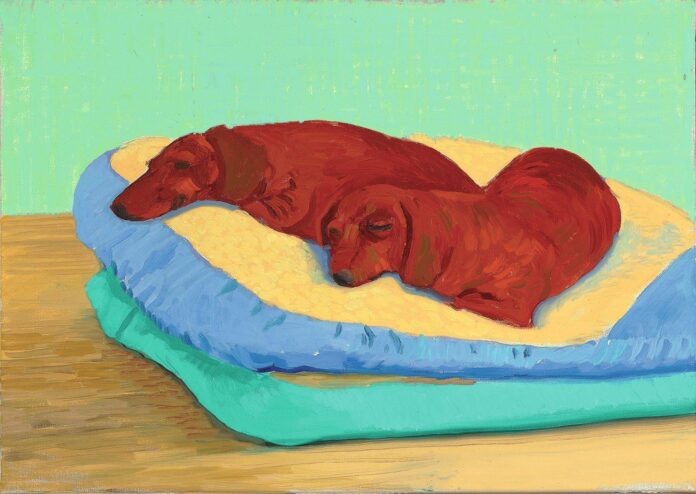Faithless and Fearless: Portraits of Dogs (2021) by Xavier Bray
A painter’s palette, a Shakespeare tome and a dog named Trump. When William Hogarth created a self-portrait in 1749, he decided that his pet pug was among the most important aspects of his life. Such was his love of Trump that his contemporary Samuel Ireland noted that Hogarth “had conceived a greater share of attachment than is usually bestowed on these domestic animals”.
This is just one of the many instances of artist’s depicting dogs in Faithless and Fearless: Portraits of Dogs, published ahead of an exhibition at London’s Wallace Collection, Portraits Of Dogs: from Gainsborough to Hockney (29 March-15 October). The show has been 20 years in the making, according to the curator and director of the museum, Xavier Bray, who says in his foreword that although paintings of dogs are some of the earliest examples of art, dog portraiture flourished in Britain from the 17th century onwards, and the exhibition aims to examine this veneration of our four-legged friends.

Faithless and Fearless: Portraits of Dogs (2021) by Xavier Bray
Elsewhere in the book are tales of Lucian Freud and his whippets, who appear throughout their lives in his paintings, one of which, Pluto, was documented from pup to a poignant painting of her grave. Meanwhile, David Hockney was so obsessed with his dachshunds Stanley and Boodgie that he painted hundreds of their portraits, setting up easels around the house ready to capture the sausage dogs wherever they slept. The artist published a book of these works called David Hockney’s Dog Days (1998); he remarked that the “subject wasn’t dogs but my love of the little creatures”.

The Dog (2021) by Emilia Will
The Dog (2021) by Emilia Will
The Dog, billed as a “joyful visual journey through the portrayal of canines in Western art”, includes more than 40 depictions of dogs drawn from Tate’s collection. One of the most prominent is Dandy the bulldog, a muse for the artist Eileen Agar and her husband, the Hungarian writer Joseph Bard, regularly appearing in photographs taken by the couple on their trips from the 1930s until around 1960, when they also encountered fellow Surrealists such as the American photographer Man Ray and the French poet Paul Éluard.
“There is Dandy sitting in the studio; Dandy taking a walk in Bath, western England; Dandy on the beach; Dandy wrestling a giant stick out of Bard’s hand; Dandy reclining on a zebra rug, or Dandy investigating some swans at the Serpentine in Hyde Park,” writes the book’s author Emilia Will. Dandy also pops up less frequently in some of Agar’s etchings including Self-portrait with Dandy, West Bay, Dorset (1934).

Bruce Weber’s Charlie Hunnam and Dylan, East Hampton, New York, 2014 © Bruce Weber
The Golden Retriever Photographic Society (2021) by Bruce Weber
The fashion photographer Bruce Weber is known for his glossy images of supermodels and ad campaigns for the likes of Calvin Klein and Ralph Lauren. But Weber is also an animal lover, capturing his family of golden retrievers on camera in an affectionate way over five decades.
The photogenic breed, and other glamorous dogs, are photographed in a multitude of locations and poses, from beaches to mock wedding ceremonies, incorporating occasionally incongruous nude shots and celebrity snaps featuring big-name stars such as Johnny Depp. For those curious about the book’s title, Weber explains that a “camera society for dogs might encourage people to share their own stories and photographs of their pet, knowing they only stay with us a short time”.
He adds: “This book is meant to celebrate them all, the founding members of the Golden Retriever Photographic Society. In spite of their chewing my archival prints on Agfa paper and tracking pine needles into my camera bag…”

Japan’s Best Friend: Dog Culture in the Land of the Rising Sun (2022) by Manami Okazaki
Japan’s Best Friend: Dog Culture in the Land of the Rising Sun (2022) by Manami Okazaki
It is not just Brits and Americans who are dog obsessed. Manami Okazaki’s eccentric book looks at how in Japan dogs have been turned into deities and robots, and been depicted in Edo and Meiji-era woodblock prints, Manga cartoons and even latte foam art. Among the furry friends being fawned over is Hachikō, an Akita dog that waited at the train station every day for nine years at the time his dead master would usually return home, and came to represent a sense of eternal loyalty, immortalised in several bronze statues erected in Tokyo, Odate and even as far afield as Rhode Island in the US.

























